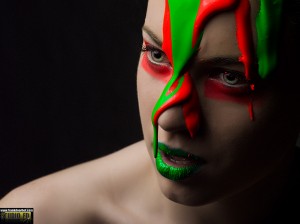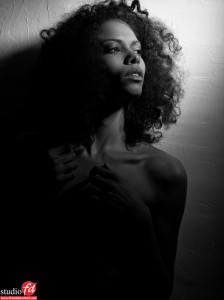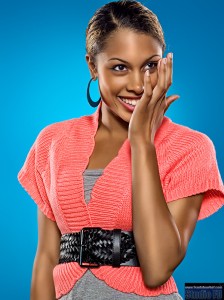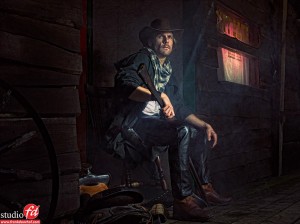I asked for it Part II
Part II of the blogpost where I answer your questions.
 Question 3:
Question 3:
Frank, jij laat via Twitter weten dat je op zoek ben naar onderwerpen. Misschien is dit wat. Ik heb en ik denk velen andere fotografen moeite met huidskleuren in de studio. Ondanks een colorchecker passport moet ik toch teveel shoppen om de huiskleur mooi te krijgen. Zeker in de donkere delen vallen ze mij altijd te rood uit.
groetjes Andre
In English (short)
How do you get the skincolors to be nice and even, even when using the colorchecker I still have too much red in the dark areas.
Answer:
First of all you have to realize how colors work.
The more black in a color the more saturated the color will look, the more white in a color the less saturated a color will look, but this is the simple theory. How does this translate into the reality of a photoshoot ?
One of the biggest problems is even skin color, this is not just for the amateur but also the pro.
A few things can be done to make it easier and the most important thing is a good MUA (Makeup Artist), and she has to do a full body makeup of course. But another thing is good heated studio, especially with cold you can get blotchy skin (often turning blue), and we don’t want that. And of course the model herself, some models will have great skin, others have blotchy skin from their own. Add to this the proper light and most problems will disappear. But also remember that certain clothing colors and backgrounds will bounce back into your models skin and can also cast casts. And last but not least some cameras are more sensitive for this than others. (and this is maybe a much bigger problem than most people think).
In photoshop however we can solve a lot of problems, but first make sure this is your last resort (why fake it, when you can create it :D).
You can of course select the skin and do a color adjustment with saturation or colortones.
But you can also select the brush, select the color mode and sample a piece of skin that is correct and now paint over the not correct parts, start out with a very low opacity and build from there. Often this works very well and you can have great results in a few minutes to even out skin without loosing detail.
Remember again that more black in a color will make it more saturated, so sample a few times in areas with the same luminosity.
*
*
Question 4 :
What is your approach to directing/posing when shooting inexperienced models? I liked your tip about centering the eye on Kelby Training. Do you have any other little tidbits like that?
Answer:
Directing a model can drive both parties totally nuts.
Some photographers are the silent types, some are the screaming types.
For me coaching is one of the most important things so I have developed a great working system over time. I use my hands to move my model from a distance. It’s a bit difficult to explain in the written word but in one of the Kelbytraining videos you can see me doing it and explaining it. In essence it boils down to the fact that when you say move left for the model this is right… when using your hands to tilt the body or tilt the head and your model is locked into your gestures it’s a great way to coach your model and it works even when you can’t make yourself clear because for example there is much noise or loud music. Everyone will do it slightly different, but for me this method works best.
*
*
Question 5 :
Hi Frank,
can you tell in general what kind of light setup you use most of the time and why. With some more in dept explanation of the function and the purpose of the lights in those situations?
Thanks in advance!
Answer :
To be honest I really can’t answer that, but I’ll try
To put it simple, there is no one light fits all solution. Sometimes you want big soft lights, sometimes I want the most narrow grid I can find to really pinpoint my light from a distance. In real live it’s all just a matter of knowing what each modifier does and finding the right modifier with the situation you want to light, it’s actually not that hard 😀
What I can answer is what I love to use and when.
As you know I’m an Elinchrom shooter, I choose them because they have some of the most awesome modifiers out there and these are my favorites:
 Number 1 :
Number 1 :
The Deep Octa.
Great modifier with lots of options, you can shoot without diffusion, with one diffusion or with two, and any combination of the two. But you can also mount the inside deflectors for even more options. I’m also using a lighttools grid on the deep octa in most cases to narrow the light even more.
Number 2 :
Medium striplights.
Somewhere in the 140×35 size area (cms).
Love them as accents or to use really nice pinpoint lighting effects without loosing the option to shoot 3/4 body shots. Also great for glamour bodyscapes.
Number 3 :
Elinchrom Maxilight/Maxispot.
Large reflector with an enormous lightoutput add it to the quadra and you will blow away the sun, add it to the Ranger and …. poor model she had such lovely eyes.
Number 4 :
Reflector with or without grid.
Really simple and delivered with almost all sets, most people don’t realize what they can do with them and that’s a shame, place it at the correct angle and the right position and you can make some stunning shots with it.
Number 5 :
Still hunting for the Elinchrom version, the Fresnel
Really unique lightsource, focussable and very very nice for portraits.
Number 6 :
The large 1.90mtr Octa.
Softlight to the max with little to no light fall off, very close to window light in optima forma, but also very nice as white background.
Number 7 :
Ringflash.
Often regarded as just flat and ugly light (and that can be true) but when used as fill light or in the correct way (meaning in the right situation) the ringflash can give you an unique look and great looking images. Most of the time I will add light to it.
Number 8 :
The Elinchrom square reflector.
Very hard to find now a days but I own one (lucky me), great for harder portraits for example males, really nice modifier but not very flexible.
Number 9 :
Available light
Can be anything from the sun to lightbulbs.
What it all boils down to is that you should understand how light works, and this is often only necessary to see that the modifiers don’t determine how a photo looks, you will have to invision the photo and than choose the modifier that fits your need, the modifier of course determines the look but in reality it should only be the tool to get your vision across.
Oh and about a backup plan for light…. yes I always use that but that’s also because you never know where you’re gone end up 😀
*
*
Question 6 :
Here I will combine a few questions about Medium format cameras and prints.
 Answer :
Answer :
I get a lot of questions about Medium Format cameras and why I choose MF while the top of the line DSLRs are now just as good. Well the top of the line DSLRs are very good, I use a 5DMKII myself and also the new Nikons are stunning but you have to realize that both systems are totally different. The most made mistake is to only look at the megapixel count and than both seem similar. However there is more.
Dynamic range.
Although some tests claim that dynamic range is equal between for example the Nikon and a MF camera I have to disagree. During the workshops I see a lot of my students shooting with DSLRs (almost all of them) and I can really say with 100% certainty that no DSLRs is equal in REAL dynamic range to a Leaf Aptus back (I don’t know about the Phase or Hasselblads but I think it’s the same). Especially in the highlights and deeper shadows the MF simply shows a lot more definition.
Sharpness.
There is no AA filter in most backs and in most cases no microlenses.
This means the files are razorsharp (but also prone to moire, which is often solved in a few mouseclicks but can be a real problem sometimes).
Color.
Although you can use colorcheckers the colors from a MF back (I talk mainly about the Leaf) are simply put more accurate and more defined.
And that’s just the start.
Think also about using syncspeeds much higher than 1/125 with strobes outside (powerpacks) you do need to use LS (Leaf Shutter) lenses but for most systems that is no problem any more. Also think about tethered shooting, although DSLRs have come a long way the tethered solutions for MF are very stable and the cameras themselves are more stable in most cases.
A lot of the differences will disappear over time, like the MP count (who needs more really), dynamic range will also change and remember that until Phase One released the IQ series the displays of most MF cameras were very bad (understatement)…. so why……
Well the most important thing I did not mention yet.
Sensor size…
That’s where the main difference lies, and even when EVERYTHING else is equal this will still be the reason for many people to choose MF cameras. You have much greater control over DOF, in the form that you can isolate your subject from the background and still be using f8 or f11 where on a DSLR you would have too much DOF. And this changes the whole look of the image and for me was the main reason to switch, the images simply look more 3D and real.
This can be seen when you switch from a crop to a Full Frame sensor, now imagine that effect twice as intense…… yep that’s MF.
*
*
More to come in Part III


Hi Frank,
thanks for the answers! Regarding question 5, I’ve an additional question. What’s your favourite lightning setup, and why?
I do mean the positions of the several lights, compared to the model.
Hi Ton,
I really don’t have a favorite setup.
It all depends on the situation and the model/styling.
Sorry….
Hi Frank,
Lots of good information here, but you lost me on the advantage of DOF with the MF vs. DSLR.
I know that DOF on MF is smaller at a given f-stop compared to a DSLR but I can’t see why it is an advantage to shoot at f/8 – f/11 on the MF instead of f/5.6-f/8 on the DSLR. I would think that using a larger aperture would mean faster recycle times on your flash since you need less light and as long as you don’t start dipping into f/2.8 and lower, most DSLR-primes will create excellent results.
I understand the advantage of DOF on the MF if you go to f/2 – unless you have a Canon 50mm f/0.95 in your bag you probably won’t be able to match the DOF with your DSLR… 😉
However, I just don’t grasp the advantage at f/11 – what am I missing? Are you talking about daylight photography where f/5.6 will be too bright? That should be corrected by a faster shutterspeed unless you are mixing flash and daylight, right?
Yes, I’m confused. 🙂
It depends on which viewpoint you review this.
I work a lot with strobes outside and for me it’s very nice that I have a shallower DOF with the MF than with the DSLR when shooting for example on f16.
For some people it will work the other way around of course.
In reality there is a rather large difference of between 1-2 stops between DSLR and MF DOF. It can be beneficial in some situations but also bad in others.
this was so good of you frank you are very giving throwing the good karma out there.
Thanks Frank,
Your anwser is just one more justification for me to upgrade to MF ASAP …
I never had the chance to use the Maxilight modifier, but I will check it out, I’ll try not to blind the model 😉
Hey frank mssn heb ik het gemist maar had je deel III van deze topic al gepost?
I combined a few posts.
But I will do something similar when I’m back next week.
Hey Frank,
This is great. I never knew most of these stuff and it’s really good of you to put this on your blog and share your knowledge to everyone else. I guess owning a decent camera isn’t going to work alone for such outstanding pictures, huh?
It’s all about telling a story, and the camera is just a tool.